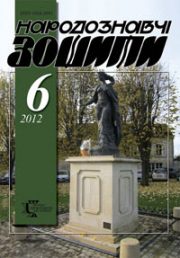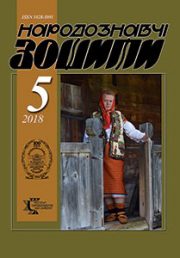The Ethnology Notebooks. 2019, № 4 (148), 898—905
УДК 398(477/82)”194/196″:393.15
DOI https://doi.org/10.15407/nz2019.04.898
DEMEDYUK Мaryna
ORCID ID: https://orcid.org/0000-0003-4415-002X
Candidate of philology sciences (= Ph.D. in philology),
Researcher at the Institute of Ethnology
of the National Academy of Sciences of Ukraine,
Dement of Folkloristic,
15, Svobody Avenue, 79000, Lviv, Ukraine.
Contacts: Е-mail: mdemedyuk@gmail.com
Abstract. Interethnic interactions are an integral part of a social system. The study of the nature of the contacts of the ruling ethnic group with national minorities in a mono-ethnic country is very relevant today. The goal of author is to clarify the specifics of interethnic interaction during the Second World War in pairs of Ukrainian-Poles, Ukrainian Jews, Ukrainian-Germans. The object of the research is the folklore narrative of the Volyn Polissya, and the subject is reflection in the texts the specifics of the contacts of Ukrainians with the adjacent ethnic groups in the conditions of wartime. The methodological basis of research is the principles of objectivity and historicism of folklore. To study interethnic interactions, the methodology of Ukrainian and foreign historians, ethno-sociologists and folk prose researchers (V. Sergiychuk, O. Bricyna and L. Mushketyk, etc.) was used. Folklore expeditions were conducted to form the source base, during which the material was recorded with the help of an oral questioning of respondents according to a pre-prepared questionnaire. The reproduction of ethnic conflicts and co-operation in the narratives of the Volyn Polissya is not sufficiently highlighted in the special research. This aspect is covered by the authors rather quickly, without proper analysis, so the basis of the work is the author’s field.
The article is devoted the problems of interaction of Ukrainians with representatives of other ethnic communities that lived compactly on the territory of Volyn Polissya during the Second World War. It turns out that changes are affecting Ukrainians with the Jewish population, ranging from passive observation and cohabitation to compassion and effort to help. The nature and causes of the Polish-Ukrainian confrontation in the Volyn Polissya, as documented in the folk stories of tragic events since the German occupation, are presented. Particular attention is drawn to the image in the narratives of the interaction of the local population of the province with the German soldiers of the regular army, which has mostly a positive connotation. The nature of the counteraction to the relationship with the German SS units, which were often confronted with inexperienced insurgents.
Keywords: ethnic intercourse, ethnic minorities, political situation, folklore narrative, oral historiographical evidences.
Received 13.06.2019
REFERENCES
Yevtukh, V.B., Troshchyns’kyy, V.P., & Halushko, K.Yu. (2003). Ethnic Sociology: Terms and Concepts. Tutorial. Kyiv: Feniks [in Ukrainian].
Savyts’ka, O.V. (2011). Ethnopsychology: a manual for the students. Kyiv: Karavel [in Ukrainian].
Hulay, V. (2006). Ethnopolitical conflicts and ethnic mobilization in Western Ukraine during the Second World War. In Ukrainian national idea: realities and prospects of development: (collection of scientific works) (Issue 18, pp. 81—86). L’viv: Publishing House of the National University «Lviv Polytechnic» [in Ukrainian].
Hulay, V. (2011). Interethnic communication in Western Ukraine during the Second World War Monograph. L’viv: Lviv Polytechnic Publishing House [in Ukrainian]. 905
Matsiyevs’kyy, Yu. (2005). Ethnic conflict as a social phenomenon: state of problem development. In Scientific notes of the Institute of Political and Ethnic Studies of the National Academy of Sciences of Ukraine: Collection. Political science and ethnology (Issue 27, pp. 298—321). Kyiv [in Ukrainian].
Lykhodid, Yu. (2003). Essence of ethnoconflict and ways to overcome it. In Scientific notes of the Institute of Political and Ethnic Studies of the National Academy of Sciences of Ukraine: Collection. Political science and ethnology (Issue 23, pp. 324—333). Kyiv [in Ukrainian].
Serhiychuk, V.I. (2003). Tragedy of Volhyn: Causes and the course of the Polish-Ukrainian conflict during the Second World War. Kyiv: Ukr. Vyd. Spilka [in Ukrainian].
Antonyuk, Ya. (2007). Activities of the OUN Security Council in Volyn. Luts’k: Volyn book [in Ukrainian].
Kalishchuk, O. (2010—2011). The problem of the Ukrainian-Polish confrontation in the West Ukrainian lands during the Second World War in historical science: the demographic section. In Ukraine-Poland: historical heritage and public consciousness (Issue 3—4, pp. 292—306) [in Ukrainian].
Pushchuk, I. (2009). Tragedy of the Ukrainian-Polish confrontation in Volyn’ 1938—1944. Rozhyshche and Manevichsky districts. Luts’k [in Ukrainian].
Silich, L. (2005) Manevichina during the German occupation of 1941—1944 rr. In Manevichina through the ages: sciences. Essay (Pp. 42—68). Luts’k [in Ukrainian].
Silets’kyy, Yu. (2009). Ethnic heterostero-types in the traditional worldview of Ukrainians: author’s abstract. (Dis … cand. of hist. sciences). L’viv [in Ukrainian].
Nikolayets’, Yu. (2017). National minorities of Ukraine during the Second World War in the context of ethnopolitical practices of warring sides: scientific discourse. In Scientific notes to the Institute for Political and Ethnonational Studies. I.F. Kuras of the National Academy of Sciences of Ukraine (Issue 5—6, pp. 321—368). Kyiv [in Ukrainian].
Stokolos-Voronchuk, O. (2003). Jews at the reception of Ukrainian humorous tradition: the problem of ethnopoetic sources. In STUDY METODOLOGY, 13 (Pp. 146—150). Ternopil’ [in Ukrainian].
Il’yushyn, I. (2001). Conflict between the UPA and the AK (Army of the Krai) during the Second World War against the backdrop of the Polish underground activity in Western Ukraine. Kyiv: Instytute of History of Ukraine; National Academy of Sciences of Ukraine [in Ukrainian].





